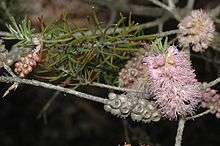Melaleuca subfalcata
Melaleuca subfalcata is a shrub in the myrtle family Myrtaceae, and is endemic to the south of Western Australia. It has fibrous bark and pink to purple flowers in spikes, mostly on the side branches.
| Melaleuca subfalcata | |
|---|---|
 | |
| Scientific classification | |
| Kingdom: | Plantae |
| Clade: | Tracheophytes |
| Clade: | Angiosperms |
| Clade: | Eudicots |
| Clade: | Rosids |
| Order: | Myrtales |
| Family: | Myrtaceae |
| Genus: | Melaleuca |
| Species: | M. subfalcata |
| Binomial name | |
| Melaleuca subfalcata | |
Description
Melaleuca subfalcata is a shrub which grows to a height of 3–4 m (9.8–13 ft) and has rough, fibrous bark. Its leaves are arranged alternately and are 8–23 mm (0.3–0.9 in) long, 0.9–2 mm (0.04–0.08 in) wide, linear to narrow elliptic in shape and curved, so that they are almost sickle-shaped.[2]
The flowers are a shade of pink to purple, arranged in a spike on the sides of the branches and sometimes on the ends of branches that continue to grow after flowering. The spikes are up to 27 mm (1 in) in diameter and contain 5 to 30 individual flowers. The petals are 2.5–4.5 mm (0.1–0.2 in) long and fall off as the flowers mature. The stamens are arranged in five bundles around the flower, each bundle with 11 to 22 stamens. Flowers appear from November to March and the fruit which follow are woody capsules, 2.5–3.5 mm (0.1–0.1 in) long, sometimes arranged in clusters.[2][3]

Taxonomy and naming
Melaleuca subfalcata was first formally described in 1847 by Nikolai Turczaninow in "Bulletin de la classe physico-mathematique de l'Academie Imperiale des sciences de Saint-Petersburg".[1][4] The specific epithet (subfalcata) is from the Latin word falcatus meaning "curved" or "sickle-shaped"[5]:237 and the prefix -sub meaning “under”[5]:826 in reference to the leaves being curved, almost like a sickle.[2]
Distribution and habitat
This melaleuca occurs in and between the Ongerup, Lake King and Israelite Bay districts[2] in the Esperance Plains, Jarrah Forest and Mallee biogeographic regions.[6] It grows in sand or clay over laterite on undulating plains and rocky hillsides.[7]
Conservation
Melaleuca subfalcata is listed as "not threatened" by the Government of Western Australia Department of Parks and Wildlife.[6]
References
- "Melaleuca subfalcata". APNI. Retrieved 25 April 2015.
- Brophy, Joseph J.; Craven, Lyndley A.; Doran, John C. (2013). Melaleucas : their botany, essential oils and uses. Canberra: Australian Centre for International Agricultural Research. p. 349. ISBN 9781922137517.
- Holliday, Ivan (2004). Melaleucas : a field and garden guide (2nd ed.). Frenchs Forest, N.S.W.: Reed New Holland Publishers. pp. 278–279. ISBN 1876334983.
- Turczaninow, Nikolai (1852). Bulletin de la classe physico-mathematique de l'Academie Imperiale des sciences de Saint-Petersburg, Volumes 10-11. St. Petersburg. p. 342. Retrieved 25 April 2015.
- Brown, Roland Wilbur (1956). The Composition of Scientific Words. Washington, D.C.: Smithsonian Institution Press.
- "Melaleuca subfalcata". FloraBase. Western Australian Government Department of Parks and Wildlife.
- Paczkowska, Grazyna; Chapman, Alex R. (2000). The Western Australian flora : a descriptive catalogue. Perth: Wildflower Society of Western Australia. p. 398. ISBN 0646402439.